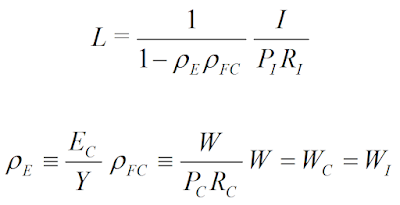Comment on Simon Wren-Lewis on ‘UK monetary policy: you cannot be serious?’
Blog-Reference and Blog-Reference on Jun 22
Simon Wren-Lewis clarifies: “When I recently wrote about increasing the inflation target, I knew I would get at least one comment saying wouldn’t this reduce real wages even further. As I always do, I explained that raising the inflation target should raise the rate of increase of all nominal quantities by the same amount, which is what economists mean by inflation. But it seems the same basic point has to be made to these three members of the MPC too: inflation is not just the rate of change of the consumer price index.”
What economists mean by inflation is false and this is relevant to the relationship between inflation and employment.
From the axiomatically correct macroeconomic Employment Law#1 follows that employment L depends (i) on aggregate demand, which is here given with the expenditure ratio ρE and investment expenditures I, and (ii), on the price mechanism, which is formally embodied in the macro-ratio ρF≡W/PR with W = average wage rate, P = average price, and R = average productivity.
Let ρE and I be fixed and the rate of change of productivity R for simplicity be zero, i.e. r=0, then there are three logical cases:
(i) The rate of change of the wage rate W is equal to the rate of change of the price P, i.e. w=p, then employment does NOT change NO MATTER how big or small the rates of change are.
(ii) If the rate of change of the wage rate is greater than the rate of change of the price then employment INCREASES.
(iii) If the rate of change in the wage rate is smaller than the rate of change in the price, then employment DECREASES.
So, it is DIFFERENCES in the rates of change in wage rate and price and NOT the absolute magnitude of change that affects employment. Every perfectly SYNCHRONOUS inflation/deflation is employment-neutral, that is, employment sticks indefinitely where it actually is.
Perfectly synchronous inflation/deflation is, according to Simon Wren-Lewis, “what economists mean by inflation”. Synchronous=employment neutral inflation, though, is a LIMITING case that occurs with a probability close to ZERO.
In general terms, the neutrality condition reads w=p+r+pr. Therefore, it is a matter of indifference whether the wage rate falls or rises or whether wages are sticky or not. It ALL depends on relative changes. Employment increases if w is greater than p+r+pr and decreases in the opposite case.
So, what is needed in the present situation is asynchronous inflation, more specifically, w greater than r and p=0. This increases also the multiplier effect of expansive fiscal policy. Increases in the average wage rate have to take the lead.
Egmont Kakarot-Handtke
#1 The elementary version of the correct (objective, systemic, behavior-free, macrofounded) Employment Law is given on Wikimedia AXEC62b
